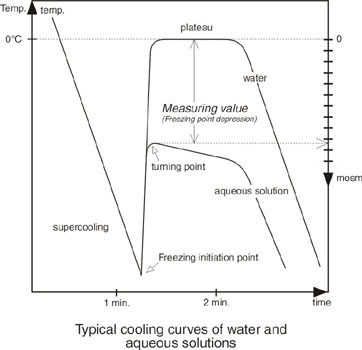Osmometry und Osmolality
Osmolarity - Osmolality
These terms describe the molecular concentration of all molecules being effective osmotical in a solution in the medical-biological area. Osmolarity is the molecular concentration in relation of the volume of a solvent. Osmolality is related to the mass of a solvent. With Löser - Osmometers you will measure Osmolalities.Osmotic Pressure
In practice the osmolality is a measure for the total number of all soluted particles in a solution. The osmolality x of a given aqueous solution is defined as follows: x = u x Nmol with u = 1 if the solution is undissociated, otherwise u is correlating to the total number of ions are existing or may have formed in a molecule of solution. Nmol = Number of moles of undissociated substance.Osmolality is measured in osmol (osm), very common in milliosmol (mosm). If not otherwise described the osmolality is measured by determining the freezing point depression. The freezing point depression and the osmolality are related by this formula:
Measuring Principle
The freezing point of aqueous solutions is measured. The freezing point depression in comparison to pure water is a direct measure of the osmotic concentration. Pure water freezes at 0 °C; an aqueous solution with an osmolality of 1 osmol / kg H2O freezes at –1.858 °C. 1 Mol of a substance dissolved in 1 kg of H2O gives a solution with an osmotic concentration of 1 osmol / kg H2O only if it is an ideal solution and if the substance does not dissociate.Function and Description
The Löser-Osmometer transports the warmth via cooling surfaces into the atmosphere, an extra water supply is not necessary. Operation of the instrument requires only an electrical socket. The temperature on the cold side is kept electronically constant.
During the measuring process the temperature of the sample is measured by a thermistor (a temperature dependent resistor). This is part of the measuring head onto which the tube is placed. The measuring head is attached to guide rods which protect it from accidental damage. At a defined supercooling the freezing process is started by lowering a needle with ice crystals into the sample tube. The freezing point of the sample is reached. The method of initiating the freezing process is important for the reproducibility of measurements. Dipping a needle with ice crystals into the sample gives more exact results than stirring with a wire which is constantly dipping into the sample.
Because of linear correlation between osmolality and freezing point the measurement of freezing point is a determination of osmolality. The results are displayed as mosm / kg H2O.
Field of Applications for Osmometer

